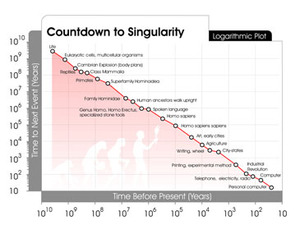The Singularity
For decades, scientists and thinkers have predicted a drastic change in the way technology advances. Once humans build a machine capable of building a better version of both itself and other machines, humans will no longer be required for technology to advance. With humans removed from the loop, the speed at which technological advancement would take place has the potential to reach a profound velocity.Many scientists and futurologists believe that this change will lead to an event that has come to be called the Singularity. To give you an idea of what the Singularity might entail, it’s time to get sci-fi: imagine a world in which there’s no distinction between humans and machines.
Nanobots inhabit our bodies, and are capable of reversing the ageing process and creating virtual environments by plugging directly into our nervous systems. Processors operate in terahertz, any product can be made from any physical material and the very fabric of space time is saturated with information.
It’s far-out speculation, and even more so when you consider that many authors on the subject believe this will happen in our lifetimes. The most famous proponent of this theory is entrepreneur, author and inventor Ray Kurzweil. Far from being a mad, disregarded scientist working in his garden shed, Kurzweil’s fans include Bill Clinton and Bill Gates, while The Wall Street Journal has described him as a ‘restless genius’.
In his book 'The Singularity is Near', Kurzweil cites many examples of exponential growth in the information technology world. Graphs of technological progress – chip speed and size, digital storage, the speed of information transfer – are all increasingly steep; they point, he claims, towards the inevitability of the Singularity taking place. It isn’t only the general onwards march of silicon that Kurzweil cites. He also focuses on many specific examples of advancements made by universities and companies such as IBM in the fields of nanotechnology and molecular computing.
In May 2007, IBM announced the first application of a self-assembling nanotechnology technique that emulates the process used by nature in the construction of seashells and snowflakes. Consider this and the general trend towards faster and smaller microchips, and it’s easy to see why Kurzweil believes the Singularity is near.
As we mentioned at the start of the article, there’s a split between those who believe that AI is a matter of simply producing with the necessary power, and those who believe that it’s a matter of understanding. Kurzweil is definitely in the former camp; those in the latter group believe that talk of the Singularity happening within our lifetimes is nothing but a fantasy.
One of Custom PC magazine’s regular contributors, James Morris, is the author of a recent book on the topic of sentient machines, 'Can Computers Create Art?’ In his book, he uses art as a prime example of what makes humans fundamentally, and perhaps indivisibly, different to machines. Superhuman processing power or not, it’s pretty difficult to imagine a computer sitting down, paintbrush and pallet in hand, and creating a work of art.

Kurzweil predicts that the rate at which computing power
has exponentially increased means the Singularity
is drawing ever near
Singularity sceptics believe that there’s more to consciousness and sentience than raw computing power. There are many theories that attempt to explain what ‘more’ is, and these have been debated for hundreds, if not thousands, of years. The theories range from the ancient, such as the religious conception of the soul, to the brand-new, such as the idea of quantum consciousness. It hasn’t yet been proved, but it’s based on the exciting field of quantum physics.
"Quantum consciousness is the theory that classical physics can’t explain human consciousness," Morris explained. "Instead, quantum mechanical processes are considered to be at the basis of the reflective mind. It’s just a theory at the moment, but the sizes of elements in the brain are small enough to imply that quantum effects could be significant. So it has plausibility, and at least provides a hypothesis rather than merely assuming that enough computing power will spontaneously produce consciousness as if by magic."
There’s the rub – an apt phrase, of course, as it’s derived from ‘Hamlet’, one of the pre-computer age’s most famous fake sentient beings. Who can say if the most powerful computer we can create will become self-aware simply because it’s fast?
Equally, who can say that, with the gradual accumulation of intelligence in projects such as Polaris and Stanley, it won’t? Whatever your opinion of the subject, one thing is very clear: the next couple of decades promise to bring some very exciting developments in the areas of both personal computing and artificial intelligence.

MSI MPG Velox 100R Chassis Review
October 14 2021 | 15:04










Want to comment? Please log in.